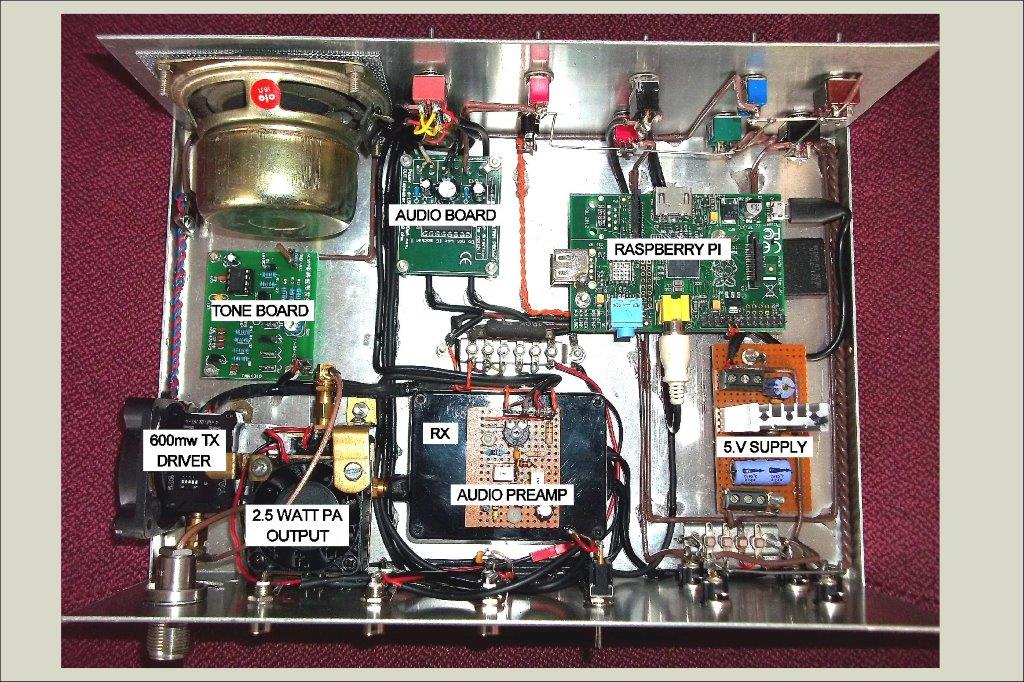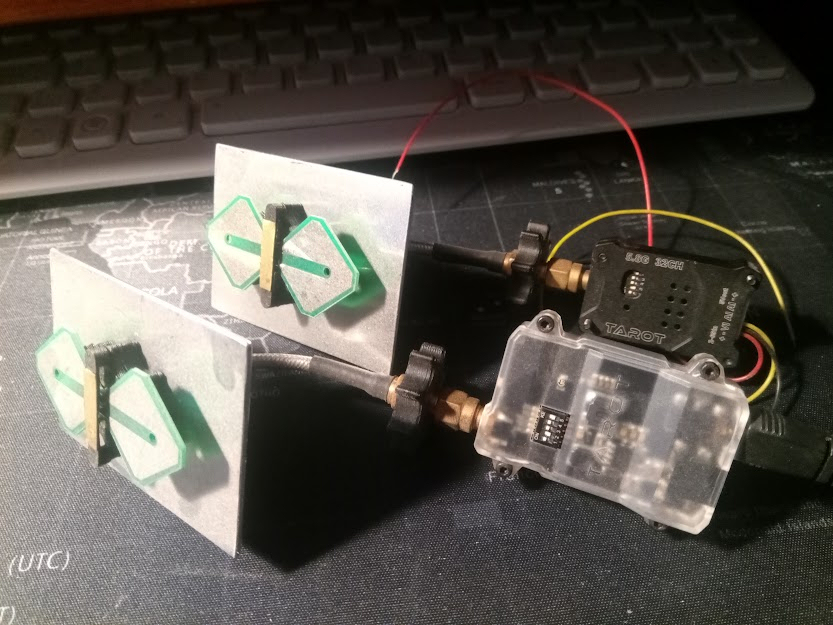
This page is currently under construction and will eventually offer our findings and advice with regard to transmitters, receivers and antennas for analogue ATV in the 6cm band.
Introduction
Welcome to the KTG 6cm page. The sections below are based on our own experiences over several years experimenting and learning about the band. 6cm offers an easy entry to ATV, particularly analogue (which is our preferred mode), with a plentiful supply of FPV equipment cheaply available on the web, particularly Ebay and Banggood. Very low power levels with simple antennas enable operation over useful distances if the path is clear and even if not so clear it's surprising what can be achieved. Tiny antennas can produce amazing results, are easy to intall, and be quite inconspicuous when high up. Such small antennas also make portable working less of a chore. My thanks to Brian, G6PKS (Herne Bay), for devoting much time and effort to testing and constructing, the other end of the link between us, which has been and continues to be, invaluable. Chris, G4AYT (Whitstable).
Transmitters
Above: The 2W TX at G4AYT located in the loft. Layout: Top left - Tone generator, Bottom left - Mic pre-amp for local mic, Centre under fan - Tarot 600mW driver TX, Right under fan - 2W PA module.

Above: The neatly constructed, as ever, 6cm ATV transceiver by G6PKS. The unit is based on the Tarot TX and RX but has the addition of a tone generator for antenna alignment, a microphone pre-amplifier, a Raspberry Pi computer for testcard generation, a 2.5W PA and an RX audio amp to drive the internal LS. A single antenna has to be manually changed between RX and TX aerial sockets as required, a microwave changeover relay was tried, however, the additional losses proved too great.
 Opposite
right: Andy's, 2E0BAY (Gillingham), Tarot TX and RX on the bench with
double diamond antennas fitted. The Tarots usually come as a combo and
don't appear to be available separately. Unlike most FPV TX and RXs
these units have two sound channels, 6.00MHz and 6.50MHz, which can be
very useful. They are a bit more expensive than other options. Another
drawback is the RX is not as sensitive as some others with a single sound
channel, by as much as -6dBm or more. The antennas Andy is using here are
linear polarised (vertical, as in the picture, or horizontal when
the 'diamonds' are one above the other). More usually FPV antennas
are designed for vertical polarisation and are omnidirectional
with little gain, with the exception of the circularly polarised
helicals. These double diamond antennas have some gain and
directivity, and like the Tarots, are available on Ebay. Important note -
Some of the leads supplied with the Tarot RXs have been found to have the
video out on the red RCA connector, not the expected yellow
one!
Opposite
right: Andy's, 2E0BAY (Gillingham), Tarot TX and RX on the bench with
double diamond antennas fitted. The Tarots usually come as a combo and
don't appear to be available separately. Unlike most FPV TX and RXs
these units have two sound channels, 6.00MHz and 6.50MHz, which can be
very useful. They are a bit more expensive than other options. Another
drawback is the RX is not as sensitive as some others with a single sound
channel, by as much as -6dBm or more. The antennas Andy is using here are
linear polarised (vertical, as in the picture, or horizontal when
the 'diamonds' are one above the other). More usually FPV antennas
are designed for vertical polarisation and are omnidirectional
with little gain, with the exception of the circularly polarised
helicals. These double diamond antennas have some gain and
directivity, and like the Tarots, are available on Ebay. Important note -
Some of the leads supplied with the Tarot RXs have been found to have the
video out on the red RCA connector, not the expected yellow
one!
600mW transmitters are cheap and available (Ebay, Banggood etc.), but many have an on board microphone, not ideal for ATV purposes. Those with a 'line in' for audio require some external gain, the level from most audio mixers or pre-amps is usually sufficient. An isolating capacitor on the TX line input is advisable, about 100nF works fine. The sound sub carrier frequency is 6.5MHz, although as already mentioned, the Tarot TX is an exception having also a 6.0MHz sub carrier. All have a standard video input (1V pk/pk) of course. Most TXs get hot, some very hot, this seems to be the norm, so a small fan is a good idea. One vendor on Ebay recently was selling 600mW TXs with audio line in for around 2GBP! So it's not expensive to give it a go.
TXs are available at the 2W level, as are PAs for 2 or slightly more watts with 600mW drive. But some caution is required here as they are easily destroyed. Never turn any of these TXs or PAs on without an antenna connected, a decent fan is required on the higher power units too. It also makes sense to run them close to the minimum voltage needed, to minimise regulator heat.
Antennas
Above left is the G6PKS end of the link, clearly showing the flat 'Gibeon' antenna on its own 2" mast. This antenna is fed with S400 cable which goes straight through the wall near the mast lower bracket and into the radio room directly the other side.
Above right shows the two 6cm antennas, one for transmit and one for receive at G4AYT, below the 23cm yagi. These flat 'Gibeon' antennas have very high gain and narrow beamwidth and are available on Ebay or direct from the manufacturer, yagi.pl in Poland (cheaper direct from the manufacturer but payment is more complicated and there is obviously a delay with delivery). However, highly recommended. They are made using weather and sun resistant materials to a very high standard and can be mounted for horizontal or vertical polarisation. The connector is a gold plated 'N' type socket. With any antenna at this frequency very good quality low loss cable and the shortest of runs is essential, LMR-400 (S400) with a quoted loss of 33.5dB/100m at 5.8GHz is particularly good although cables like Westflex103 are satisfactory, but really only for a very few metres. Better still, connect the RX/TX directly to the antenna - easier with the RX as the TX can get very hot and usually requires a fan, weatherproofing is then an issue. The same antenna can, of course, the used for TX and RX, but then either physical changeover or a relay is required, and the latter has found to be quite lossy at these frequencies, additional connectors may also be required, introducing more loss.
These antennas at G4AYT are used for the link to G6PKS and G8NAV, but are rotatable within a few minutes by arrangement and can comfortably reach a range of 20km or more over a good path with a few hundred milliwatts TX power using analogue ATV.
Regarding loss mentioned above, we all know connectors and adapters introduce loss, even more so at 6cm, so use as few as possible. Some will be inevitable, for instance the antenna N-type to the RX/TX which will probably have an SMA. But beware, confusion can arise with the two types of SMA connector: there is the standard type and the RP type.
LMR-400 cable is readily available in convenient lengths on Ebay, but is quite expensive, and if you're prepared to pay the price, with connectors fitted.
'Local' Activity on 6cm
We have started putting together a collection of photos of 5GHz TV activities around the County and nearby. To view these to date take a look HERE and feel free to submit any of your own for inclusion if you'd like to show us what you've been up to or seen on the band, via the address at the top of the Home Page.
Return to Home Page BACK.